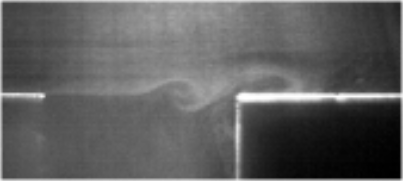Cavity tone
Radiation of cavity tones by the self-sustainedoscillations with the fluid-acoustic interactionsbecomes a problem in a high-speed train etc.
Our objective is to clarify the mechanism of theradiation and establish the decrease technique of thecavity tones. The direct computations and windtunnel experiments of the simultaneousmeasurements of the flow and sound are done.

Vortices and acoustic waves (DNS)

Visualized flow
Related publications
- 寺尾啓太郎, 横山博史, 大峠祐介, 飯田明由, "キャビティ音発生機構に基づいた新たな周波数予測式の提案", 日本機械学会論文集B編,77(779), pp. 1522-1532, 2011. J-STAGE
- Hiroshi Yokoyama and Chisachi Kato, Fluid-Acoustic Interactions in Acoustic Radiation in Turbulent Cavity Flows (Fluid-Dynamic Oscillations),Journal of Environment and Engineering,6(1), pp. 90-106 (2011). J-STAGE
- 横山博史, 加藤千幸, "乱流境界層内のキャビティ音発生におけるフィードバック機構(第2報,流体共鳴振動)", 日本機械学会論文集B編,76(765), pp. 804-813 (2010). J-STAGE
- Hiroshi Yokoyama and Chisachi Kato, "Fluid-acoustic interactions in self-sustainedoscillations in turbulent cavity flows. I.Fluid-dynamic oscillations,"Physicsof Fluids21, 105103 (2009). J-STAGE
- 横山博史, 加藤千幸, "乱流境界層内のキャビティ音発生におけるフィードバック機構(第1報,流体力学的振動),"日本機械学会論文集B編,75(760), pp. 2369-2378 (2009). 【機械学会論文賞】 J-STAGE
